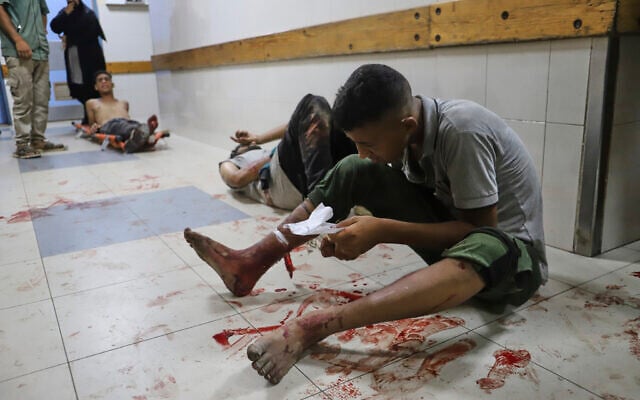



After the White House announced last month that it would establish a new plan to distribute aid to Palestinians due to the mounting hunger crisis in Gaza, the State Department indicated on Tuesday that the administration has ultimately decided to suffice with expanding the existing Gaza Humanitarian Foundation’s delivery system.
“President Trump wants to alleviate the suffering of the people in Gaza at the hands of Hamas. He has committed to remaining involved and helping facilitate the aid situation — to build upon GHF’s work, and to help Gazans attain the critical access to food aid that they need,” US State Department spokesperson Tammy Bruce said during a press briefing.
On July 28, Trump announced the US would establish new “food centers” in the Gaza Strip, which would be run by Israel.
The announcement surprised many in Jerusalem, who thought the United States would back the establishment of additional distribution sites run by the GHF, rather than create a new mechanism.
But on July 29, the White House confirmed that Trump planned to do just that and that details on the new plan would be forthcoming.
A few day later, US special envoy Steve Witkoff and US Ambassador to Israel Mike Huckabee entered Gaza to tour a GHF distribution site, with the White House saying that the visit was aimed at “secur[ing] a plan to deliver more food and meet with local Gazans to hear firsthand about this dire situation on the ground.”
While no rollout of a new plan has been issued, Huckabee said in an August 6 interview that GHF sites would be scaled up from the three that currently exist to 16, and that they would operate 24 hours a day.
Asked to confirm that the US was indeed moving to expand GHF rather than establishing a new aid distribution mechanism, a State Department spokesperson told The Times of Israel on Tuesday that they had nothing to share beyond what Huckabee said last week. “These are ongoing conversations with Israel,” the spokesperson said.
Prime Minister Benjamin Netanyahu indicated during a press conference on Sunday that Israel is also planning to expand the number of GHF sites, though there have been no signs on the ground that new distribution centers are being constructed.
Aid organizations and much of the international community is opposed to GHF, as it requires Gazans to walk long distances in order to pick up a box of dry food products that need to be prepared elsewhere in the Strip where cooking fuel and equipment are scarce.
While the mechanism was established to try and box Hamas out of the aid process, the desperation of hungry Gazans after an Israeli blockade extended from March through much of May has led to chaotic scenes at GHF sites where thousands of people burst through the entrances each day to grab boxes of food as quickly as possible.
There is no registration process to ensure that Hamas operatives are not among those benefiting from the aid, and stronger segments of the population, able to weather the difficult trek to the distribution sites, are the primary beneficiaries, at the expense of more vulnerable Palestinians who are most in need of aid.
What has most dominated headlines since the rollout of GHF has been the repeated shootings of those trying to reach their aid sites.
The UN has reported that over 1,000 people have been killed in these shootings. While the Israel Defense Forces has been blamed, it has said death toll figures have been inflated, that it only fires warning shots at those who pose a threat and that Hamas operatives and other gunmen are also opening fire at aid seekers from within the crowd.
In recent weeks, UN figures have shown a greater proportion of the Israeli fire has been directed toward Gazans converging on UN humanitarian aid convoys than those trying to reach GHF sites.
Sharing new details on Witkoff and Huckabee’s visit to the GHF site in Rafah, Bruce said Tuesday that the pair saw firsthand the “incredible work” of GHF, which says it has been able to provide nearly 119 million meals for Gazans. The figure is calculated by adding up the calorie count of the dry food products that are in each box, which is meant to supply enough food for about five people for roughly three days.
Witkoff and Huckabee were also briefed on the “regrettable dynamic of UN assistance trucks getting looted upon entry into Gaza,” Bruce said. That briefing was apparently carried out by Israeli officials and GHF staffers, as UN officials were not reported to have taken part in the visit.
Roughly 90 percent of the UN’s aid was looted before reaching its intended destination in the month of July, according to the body’s own figures. Israel has accused Hamas of stealing significant portions of aid, though UN officials maintain that most humanitarian assistance is taken by hungry Gazans due to the high levels of food insecurity, which have started to come down as Israel has allowed more aid into the Strip in recent weeks.
Bruce said that UN assistance that is not looted “is subject to extraordinary taxes by Hamas authorities” when it is sold on the black market.
While Trump has repeatedly claimed that his administration has given $60 million to GHF, Bruce confirmed that the real number pledged by Washington is $30 million and that only half of it has been distributed to date.
The US has been privately urging countries to donate to GHF, but has had very little success, with Gulf countries turning them down and preferring to donate through either their own existing channels or through the UN. GHF’s executive director Johnnie Moore has privately told prospective donors that a number of Eastern European countries have donated to the organization on condition of anonymity, a Western diplomat told The Times of Israel.
Other than the US, Israel is the only country to publicly confirm donating to GHF. Finance Minister Bezalel Smotrich last week acknowledged advancing the transfer of $875 million from Israeli public coffers toward the provision of humanitarian aid to Gaza, after having previously opposed the entry of any assistance to the Hamas-ruled enclave.
GHF will likely have a harder time scaling up its operations if no other countries donate, however.



